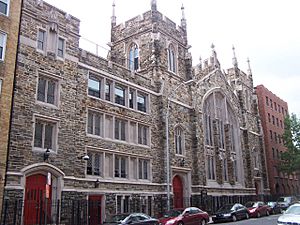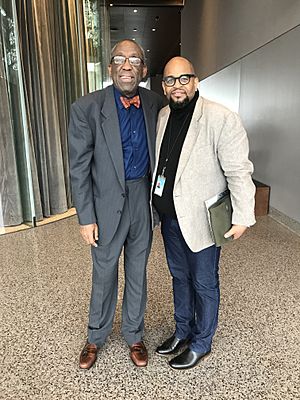Abyssinian Baptist Church facts for kids
Quick facts for kids Abyssinian Baptist Church |
|
|---|---|
 |
|
| Location | New York City |
| Country | USA |
| Denomination | National Baptist Convention, USA |
| History | |
| Founded | 1808 |
| Founder(s) | Thomas Paul |
The Abyssinian Baptist Church is a famous Baptist church located in the Harlem neighborhood of Manhattan, New York City. It is known for its important role in the African American community. The church is connected to the National Baptist Convention, USA.
It was founded in 1809. The building you see today was built in 1922–23. It was designed in a beautiful style called Gothic Revival. This style often includes pointed arches and stained glass windows. The church has many lovely stained glass windows and marble decorations.
Throughout the 20th century, important leaders like Adam Clayton Powell Sr. and Adam Clayton Powell Jr. served as ministers here. The church has always been a key place for African American faith, community, and social action.
Contents
History of the Church
The church started because of an important event in 1808. At that time, many churches had separate seating for people of different races. Some free sailors from Ethiopia (then called Abyssinia) and their African American friends protested this unfair rule at the First Baptist Church. They decided to leave and start their own church. They named it the Abyssinian Baptist Church, after the historic name of Ethiopia.
The congregation met in several places over the years. They moved from one location to another as their community grew. In 1856, they settled in Greenwich Village, an area sometimes called "little Africa." Later, around 1902, many African American people moved uptown to Harlem. The church moved with them.
In Harlem, the church grew very quickly. This was especially true after Adam Clayton Powell Sr. became the pastor in 1908. He was a powerful speaker. The church bought land for a new building, which was paid for by the generous donations of its members.
A German Theologian's Visit
In 1930, a young German student named Dietrich Bonhoeffer came to New York. He was studying at the Union Theological Seminary. A fellow student introduced him to the Abyssinian Church. Bonhoeffer taught Sunday school there. He also grew to love African American spirituals, which are religious songs. He even took a collection of these songs back to Germany.
Bonhoeffer heard Adam Clayton Powell Sr. preach about social justice. This experience helped him understand the unfairness faced by minority groups. He also saw how the church could help bring people together. He said that at Abyssinian, he truly learned about "sin and grace and the love of God." He felt that "the Black Christ is preached with rapturous passion." This time in New York deeply influenced his later work. He became a strong opponent of the Nazi regime in Germany. He spoke out against their persecution of Jewish people. For his beliefs, Bonhoeffer eventually lost his life.
By 1930, the Abyssinian Baptist Church had 13,000 members. This made it the largest African American church in New York City. It was also the largest Baptist church in the world. In 1937, Adam Clayton Powell Sr. passed the leadership to his son, Adam Clayton Powell Jr..
Adam Clayton Powell Jr. became the first black Congressman from New York City. He served 14 terms in the United States House of Representatives. His strong leadership and amazing preaching made the church very influential in the African American community.
The funeral of David Baldwin, the stepfather of author James Baldwin, was held at the Abyssinian Baptist Church. This happened during the time of the 1943 Harlem riot. James Baldwin wrote about attending his father's funeral in his famous essay, Notes of a Native Son.
Civil Rights activist Fannie Pennington was a dedicated member of the church for her entire life. Raphael Warnock, who is now a U.S. Senator, also served as an assistant pastor and youth pastor at Abyssinian.
Music and Culture
The Abyssinian Baptist Church was a very important place for religious music during the Harlem Renaissance. It continues to be a center for gospel music in Harlem today. The famous jazz musician Fats Waller played the organ at Abyssinian. His father, Edward Martin Waller, was a minister there.
Many important events have taken place at the church. It hosted the wedding of singer Nat King Cole and his wife Maria Cole. The funeral of "The Father of Blues," W. C. Handy, was also held there in 1958.
The Church Today
After Adam Clayton Powell Jr., Samuel DeWitt Proctor became the pastor. He was followed by Calvin O. Butts. Under the leadership of Pastor Butts, the church has remained a vital part of New York City. It is important for politics, social work, and religious life.
In 1989, Pastor Butts started the Abyssinian Development Corporation (ADC). This is a non-profit group connected to the church. It works on community development and social services. The ADC has helped create many new projects worth millions of dollars. These include the first new high school in Harlem in 50 years. They also built the first large supermarket and new housing.
In 1989, the church was one of the first to support Pernessa C. Seele's idea for a Harlem Week of Prayer. This event helped bring together religious communities to support people with AIDS and their families. Seele later founded Balm in Gilead, Inc. This is an international non-profit group. It provides education and prevention for HIV/AIDS. It also develops other health programs in the United States, Africa, and the Caribbean.
See also
 In Spanish: Iglesia Bautista Abisinia para niños
In Spanish: Iglesia Bautista Abisinia para niños


